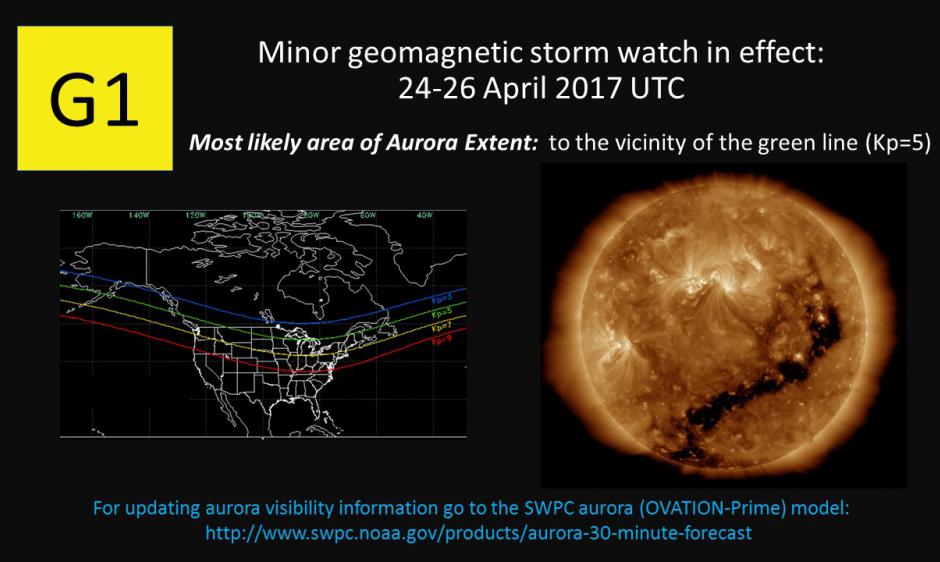Those Evasive Northern Lights
2017-04-24 23:15:02.000 – Caleb Meute, Weather Observer / Meteorologist
The first five days of this shift were spent in the clouds before clearing finally occurred yesterday morning, April 23rd just before sunrise. Beautiful weather continued through the day and night with mostly clear skies overhead that made me rather hopeful of seeing a display of the Northern Lights Sunday night. Seeing the Northern Lights from here atop the Rockpile is not a common occurrence, although occasionally during a Solar Storm it becomes possible. Since I began work as a Nighttime Weather Observer one year ago, there have only been a few nights where I have actually been able to see this beautiful phenomena. Conditions rarely matchup between a significant solar event and fog-free conditions or clear skies. With that being said, last night there seemed to be a decent chance at seeing the Lights.
On April 19th, A Coronal Mass Ejection (CME) erupted from the sun and it was expected to miss earth; however, a glancing blow resulted and led to some beautiful auroral displays, especially near the Earth’s poles. This of course occurred while the summit was shrouded in the fog and our view more resembled gray, followed by black construction paper overnight. The solar storm associated with that CME subsided prior to last night, but a coronal hole (CH) opened up in the sun’s atmosphere facing earth. A coronal hole is a place in the sun’s atmosphere where the magnetic field peels away and allows solar wind to escape. Here on Mount Washington, we get some pretty serious winds, but they don’t quite compare to solar winds… With this particular CH, winds erupted towards earth at 700 km/s or (Thanks to Google conversions) 434.96 miles per second. Every time I start driving that fast I get a speeding ticket… I had to ditch my Honda Civic because speeds that fast just seem like you are cruising. On a more serious note – those winds carry gaseous material which are full of “negative polarity” magnetic fields. These fields connect to Earth’s magnetosphere and energize geomagnetic storms that appear to us as the beautiful dancing Northern Lights. Per the Space Weather Forecasters at NOAA, there is a 60% chance of G1 class storms tonight (April 24th-25th). I ended up not being able to see the Aurora last night and it seems as though the chances have waned slightly for tonight also. The KP index is just under a five tonight which makes the most likely area of Aurora Extent over extreme northern Maine. With this particular solar event, here on the Rockpile, we did not get to see the Aurora, but it is always exciting when there is a chance. Each observation takes me a bit longer as I stare northward waiting for my eyes to adjust in hopes of coding that illustrious AURBO (METAR code for Aurora Borealis).

It is important to note, that the Mount Washington Observatory does not forecast space weather, nor do we serve as a source for space weather information. We do however enjoy looking for the Northern Lights and occasionally capturing images/video so that we can share them with everyone. If you are seeking information on solar activity, you should visit www.swpc.noaa.gov. Several different phone application’s also exist which take your GPS location into account and interpret the Space Weather Prediction Center information for a more unique forecast at your location. I use “Aurora Alert” – produced by Eagle’s Orbit. This app does a great job at defining different Space Weather terminology, and at helping understand when the best chances to view the Northern Light’s will be. It also notifies me when there is an event underway on my off weeks so I can become jealous of my counterpart, Ryan Knapp.
Geomagnetic Storms (G1 tonight) – The geomagnetic storm scale is one of a number of scales created by the NOAA Space Weather Prediction Center designed as a way to communicate to the general public the current and future space weather conditions and their possible effects on people and systems. The scale runs from G1 – G5 with G1 having the lowest impact and G5 creating the most extreme impacts.
KP Index – The KP index is the most indicative value of auroral activity. The range is between zero and nine with zero indicating no activity and nine meaning extreme activity. Essentially, the higher the KP is the further towards the equator the aurora is visible. Oftentimes when the KP is at least a five and all other conditions allow for it, the Northern Lights may at least faintly be visible from the Observation Deck here on the summit.
Caleb Meute, Weather Observer / Meteorologist
Team Flags Return for Seek the Peak’s 25th Anniversary
Team Flags Return for Seek the Peak's 25th Anniversary By MWOBS Staff Mount Washington Observatory is looking forward to continuing a much-loved tradition for Seek the Peak’s 25th Anniversary: Team flags. In inviting teams
Meet Summer Interns Zakiya, Max and Maddie
Meet Summer Interns Zakiya, Max and Maddie By MWOBS Staff We are excited to welcome six teammates to the summit of Mount Washington this summer! During their internship, these students and graduates will play
Saying Goodbye to the Summit
Saying Goodbye to the Summit By Alexis George After an extraordinary last three years working as a Weather Observer and Meteorologist, I am excited to pursue a different career. As sad I as am




